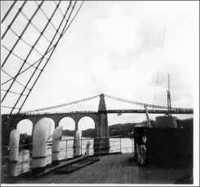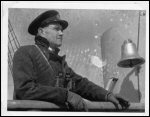|
Loss of the Ship
9. APROACH TO THE SUSPENSION BRIDGE

To understand what happened next please refer
to the chart below.

It was approximately 9.45 am. The ship
was now just ahead of the point marked 5c and barely making progress
against a growing stream. Captain King observed "We were caught
in the worst part of the channel with nowhere to go"[7].
From Swelly Rock "the prudent navigation
demands that the ship should haul to the northward in order to get on
an offing of the Platters before making for the centre of the suspension
bridge"[4] i.e. she should follow the route of the black
line on the chart. However that would have kept her in the middle of
the strengthening stream. The point marked 7c shows that where the main
course of the stream moves away from the Anglesey shore there an area
of relatively quieter water, marked "Relatively Slack Area" on the chart.
Pilot Jones junior on the forward tug realised
that if they headed off towards the Angelsey shore - through point 6c,
towards the "Relatively Slack Area" they would avoid the worst of the
current and at least be able to make some forward progress.

He took the initiative and guided them
forward into this (relatively) slower moving water[2]. On
the Suspension Bridge "observers noted what they remarked to be a sheer
to port (the ship's left)"[4]. The Inquiry thought this was
a natural aligning for the Suspension Bridge, in reality it was Jones
junior taking the initiative. They continued making very slow progress
towards point 7c. By 10am they were abreast the Platters and really
could go no further in the calmer water. Very soon they would have to
pull out into the main stream to get back into the channel under the
Suspension Bridge.
The pilots knew that if they headed off towards
the Angelsey shore - through point 6c, towards the "Relatively Slack Area" they
would avoid the worst of the stream and at least be able to make some
forward progress. On the Suspension Bridge "observers noted what they
remarked to be a sheer to port (the ship's left)"[4].
The Inquiry thought this was a natural aligning for the Suspension Bridge,
in reality it was a deliberate deviation. They continued making very slow
progress towards point 7c. By 10am they were abreast the Platters and
really could go no further in the quieter water.

|
|
Slightly ahead of them
(at point 7c, broadly the area circled as Relatively Slack Water)
between Carreg Halen and the Suspension Bridge there is a deep pool
with depths ranging from 25 feet to 48 feet at low water. The stream
eddies around it but it is outside its main strength and in a bit
of a counter current. The pilots thought they could place the ship
into this pool and hold her there for 4 hours until the strength
of the stream had abated. The ship was in extremis and had nowhere
else to go. This was a brilliantly inspirational emergency manoeuvre
which might well have succeeded. Some skeptics doubt if this manoeuvre
ever occurred, but the photo on the left clearly shows the ship
in the pool close to the Anglesey shore. |


|
|
It is a cliché to say that
command is a lonely place, but at that moment Captain Hewitt must
have known just how lonely it was. It was in the character of the
man that he did not flinch from difficult decisions. There was no
guarantee this diversion would work, meanwhile conditions were deteriorating
by the minute. He had to choose between remaining where they were
or going forward. He decided the ship had to get out of danger,
and with the Suspension Bridge tantalisingly close her safest option
was to press ahead. Shortly before 9.50 am he gave the order, and
the tugs eased Conway back out into the ever-increasing turbulent
stream i.e. to the left in the photos. She was barely a few hundred
yards short of the Suspension Bridge. |
--Previous Section | Introduction | Next Section --
|